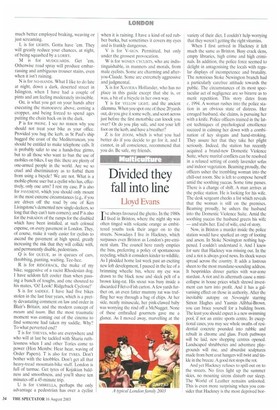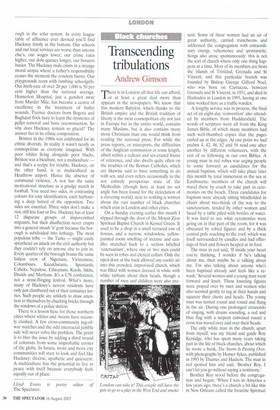Divided they fall into line
Lloyd Evans
I've always favoured the ghetto. In the 1980s I lived in Brixton, where the night sky was often tinged with volcanic orange as embittered youths took their anger on to the streets. Nowadays I live in Hackney, which surpasses even Brixton as London's pre-eminent slum. The council here rarely empties the bins, preferring a policy of spontaneous recycling, which it considers kinder to wildlife. As I plodded home last week past an exciting new loft development, I paused in the lee of a brimming wheelie bin, where my eye was drawn to the black nose and sleek pelt of a brown king-rat. His snout was busy inside a discarded Filet-o-Fish carton. A few yards further on, an even fatter mummy rat was truffling her way through a bag of chips. At her side, neatly minuscule, her pink-clawed baby was wortying the rind off a McNugget. None of these enthralled gourmets gave me a glance. As I moved away, marvelling at the
variety of their diet, I couldn't help worrying that they weren't getting the right vitamins.
When I first arrived in Hackney it felt much the same as Brixton. Busy crack dens, empty libraries, high crime and high criminals. In addition, the police force seemed to delight in antagonising the locals with regular displays of incompetence and brutality. The notorious Stoke Newington branch had a particularly carefree attitude towards the public. The circumstances of its most spectacular act of negligence are so bizarre as to merit repetition. This story dates from c. 1994. A woman rushes into the police station in an obvious state of distress. Her enraged husband, she claims, is pursuing her with a knife. Police officers trained in the latest techniques of psychological emollience succeed in calming her down with a combination of key slogans and hand-stroking. They assure her that they take her plight seriously. Indeed, the station has recently acquired a brand-new Domestic Violence Suite, where marital conflicts can be resolved in a relaxed setting of comfy lavender sofas and indoor vegetation. Beaming proudly, the officers usher the trembling woman into the chill-out room. She is left to compose herself amid the soothing yuccas. Some time passes. There is a change of shift. A man arrives at the police station. He is looking for his wife. The desk sergeant checks a list which reveals that the woman is still on the premises. Beaming proudly, he ushers the husband into the Domestic Violence Suite. Amid the soothing yuccas the husband greets his wife — and stabs her. End of wife, end of story.
Now, in Brixton a murder inside the police station would have sparked an orgy of looting and arson. In Stoke Newington nothing happened. I couldn't understand it. And I knew for sure that Hackney was missing out. In the end a riot is always good news. Its shock waves spread across the country. It adds a lustrous sheen to the most mundane-sounding address. It besprinkles dinner parties with war-zone stardust. A riot and its aftermath cause a minicollapse in house prices which shrewd investment can turn into profit. And it has a galvanising effect on those in authority. After the inevitable autopsy on Newsnight starring Simon Hughes and Yasmin Alibhai-Brown, you can brace yourself for a building boom. The least you should expect is a new swimming pool, if not an entire sports centre. In exceptional cases, you may see whole swaths of residential concrete pounded into rubble and rebuilt in chrome and glass. Fresh pathways will be laid, new shopping centres opened. Landscaped shrubberies and adventure playgrounds will rise, and absurdist sculptures made from bent coat hangers will twist and tinkle in the breeze. A good riot stops the rot.
And yet Hackney refuses to spill out on to the streets. No fires light up the summer skies, no moaning sirens disturb our sleep. The World of Leather remains unlooted. This is even more surprising when you consider that Hackney is the most deprived bor ough in the solar system. In every league table of affluence ever devised you'll find Hackney firmly at the bottom. Our schools and our local services are worse than anyone else's, our wages lower, our crime rates higher, our dole queues longer, our boozers busier. The Hackney male exists in a strange moral utopia where a father's responsibility ceases the moment the condom bursts. Our playgrounds teem with lambing schoolgirls. Our birth-rate of over 20 per 1,000 is 50 per cent higher than the national average. Homerton Hospital, just a gunshot away from Murder Mile, has become a centre of excellence in the treatment of bullet wounds. Trainee doctors from Bogota and Baghdad flock here to learn the mysteries of pellet removal and bone reconstruction. So why does Hackney remain so placid? The answer lies in its ethnic composition.
Brixton in the 1980s was celebrated for its ethnic diversity. In reality it wasn't nearly as cosmopolitan as everyone imagined. With poor whites living alongside poor blacks, Brixton was a biculture, not a multiculture — and that's a recipe for trouble. Hackney, on the other hand, is as multicultural as Heathrow airport. Hence the absence of communal violence. A riot has the same motivational structure as a grudge match in football. You need two sides, in contrasting colours for easy identification, each harbouring a deep hatred of the opposition. Two sides are essential. Three sides don't make a riot, still less four or five. Hackney has at least 12 disparate groups of impoverished migrants, but their disaffection never erupts into a general smash 'n' grab because the borough is subdivided into lethargy. The most populous tribe — the Turks — might easily spearhead an attack on the civil authority but they couldn't rely on anyone else to join in. Every quarter of the borough boasts the same listless crew of Nigerians, Vietnamese, Colombians, Kazaldistanis, Spaniards, Uzbeks, Nepalese, Ethiopians, Kurds, Sikhs, Druids and Martians. It's a UN conference, not a stone-flinging festival. What's more, many of Hackney's newest residents have only just clambered out of their container lorries. Such people are unlikely to draw attention to themselves by chucking bricks through the windows of a police station.
There is a lesson here for those northern cities where whites and Asians have recently clashed. A few cross-community tug-ofwar matches and the odd interracial jumble sale will never solve the problem. The point is to blur the issue by adding a third strand of colonists from some improbable corner of the globe. In future, more and more city communities will start to look and feel like Hackney: diverse, apathetic and quiescent. A multiculture has the potential to live in peace with itself because everybody feels equally out of place.
Lloyd Evans is poetry editor of The Spectator.











































































 Previous page
Previous page